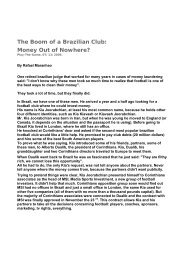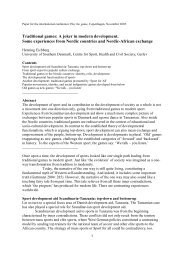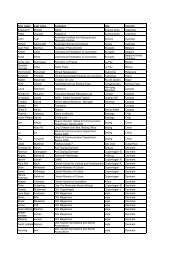Ethical issues derived from imperfect doping tests - Play the Game
Ethical issues derived from imperfect doping tests - Play the Game
Ethical issues derived from imperfect doping tests - Play the Game
You also want an ePaper? Increase the reach of your titles
YUMPU automatically turns print PDFs into web optimized ePapers that Google loves.
<strong>Ethical</strong> <strong>issues</strong> <strong>derived</strong> <strong>from</strong> <strong>imperfect</strong><br />
<strong>doping</strong> <strong>tests</strong><br />
Werner Pitsch<br />
Saarland University<br />
Institute for Sport Sciences
Four possible results of <strong>doping</strong>-<strong>tests</strong><br />
By principle <strong>doping</strong> <strong>tests</strong> can result in four different<br />
ways:<br />
<strong>tests</strong> positive<br />
<strong>tests</strong> negative<br />
doped athlete<br />
true positive<br />
false negative<br />
clean athlete<br />
false positive<br />
true negative<br />
09.06.2009 <strong>Ethical</strong> <strong>issues</strong> <strong>derived</strong> <strong>from</strong> <strong>imperfect</strong> <strong>doping</strong> <strong>tests</strong> 2
Quality Parameters of Doping-Tests<br />
The quality of biomedicine laboratory <strong>tests</strong> are first and<br />
foremost defined by <strong>the</strong> sensitivity and <strong>the</strong> specificity of<br />
<strong>the</strong> test:<br />
– Sensitivity: The probability that <strong>the</strong> test results<br />
positive if a positive sample is analyzed.<br />
– Specificity: The probability that <strong>the</strong> test results<br />
negative if a negative sample is analyzed.<br />
09.06.2009 <strong>Ethical</strong> <strong>issues</strong> <strong>derived</strong> <strong>from</strong> <strong>imperfect</strong> <strong>doping</strong> <strong>tests</strong> 3
Quality Parameters of Doping-Tests<br />
The specificity and <strong>the</strong> sensitivity of <strong>doping</strong> <strong>tests</strong> in<br />
accredited Anti-Doping laboratories:<br />
1. The „International Standard for Laboratories“<br />
contains no minimum standard values for <strong>doping</strong><br />
<strong>tests</strong>.<br />
2. Data which can be used to calculate <strong>the</strong> quality<br />
parameters are collected by <strong>the</strong> WADA <br />
3. but are treated as restricted knowledge.<br />
09.06.2009 <strong>Ethical</strong> <strong>issues</strong> <strong>derived</strong> <strong>from</strong> <strong>imperfect</strong> <strong>doping</strong> <strong>tests</strong> 4
The probability of false positive <strong>doping</strong>-<strong>tests</strong><br />
Determinants of <strong>the</strong> probability of false positive <strong>doping</strong><br />
<strong>tests</strong> and parameter estimations:<br />
1. Specificity (at least 0.999)<br />
2. Prevalence of Doping: The rate of doped athletes<br />
among <strong>the</strong> tested athletes (varying <strong>from</strong> 0 to 1)<br />
3. Number of substances or methods, each sample is<br />
tested for (varying <strong>from</strong> 0 to 200).<br />
4. Number of samples per year (200.000)<br />
09.06.2009 <strong>Ethical</strong> <strong>issues</strong> <strong>derived</strong> <strong>from</strong> <strong>imperfect</strong> <strong>doping</strong> <strong>tests</strong> 5
09.06.2009 <strong>Ethical</strong> <strong>issues</strong> <strong>derived</strong> <strong>from</strong> <strong>imperfect</strong> <strong>doping</strong> <strong>tests</strong> 6
09.06.2009 <strong>Ethical</strong> <strong>issues</strong> <strong>derived</strong> <strong>from</strong> <strong>imperfect</strong> <strong>doping</strong> <strong>tests</strong> 7
Summary<br />
1. False positive <strong>doping</strong> test results cannot be avoided.<br />
2. Consistent positive results of <strong>the</strong> A- and B-sample<br />
analyses are a strong argument for assuming a true<br />
positive <strong>doping</strong> case.<br />
3. Never<strong>the</strong>less <strong>the</strong> probability of false positive results<br />
might be ra<strong>the</strong>r high at many plausible parameter<br />
values.<br />
4. The restriction of information by <strong>the</strong> WADA inhibits a<br />
profound evaluation if <strong>the</strong> problem is dealt with<br />
seriously or if it is just neglected.<br />
09.06.2009 <strong>Ethical</strong> <strong>issues</strong> <strong>derived</strong> <strong>from</strong> <strong>imperfect</strong> <strong>doping</strong> <strong>tests</strong> 8
If you are interested in more:<br />
Pitsch, W. (2009). ''The science of <strong>doping</strong>'' revisited:<br />
Fallacies of <strong>the</strong> current anti-<strong>doping</strong> regime. European<br />
Journal of Sport Science 9, 87-95.<br />
Thank you very much<br />
for your attention<br />
09.06.2009 <strong>Ethical</strong> <strong>issues</strong> <strong>derived</strong> <strong>from</strong> <strong>imperfect</strong> <strong>doping</strong> <strong>tests</strong> 9
Dilemmas of Anti-Doping<br />
Assumption 1: Nearly every athlete uses <strong>doping</strong> techniques<br />
• The problem of false positive <strong>doping</strong> <strong>tests</strong> can be<br />
neglected.<br />
• The rate of “adverse analytical findings” (approx. 2 %<br />
p.a.) reveals that Anti Doping controlled by <strong>the</strong> WADA is<br />
a paper tiger.<br />
Assumption 2: Nearly every athlete is clean<br />
• The fight against <strong>doping</strong> has a strong deterrence effect.<br />
• The problem of false positives becomes severe, but a<br />
certain amount of positives is necessary to legitimate Anti<br />
Doping.<br />
The tension zone for Anti-Doping:<br />
Obvious<br />
Moral hazard<br />
Ineffectiveness<br />
09.06.2009 <strong>Ethical</strong> <strong>issues</strong> <strong>derived</strong> <strong>from</strong> <strong>imperfect</strong> <strong>doping</strong> <strong>tests</strong> 10
















